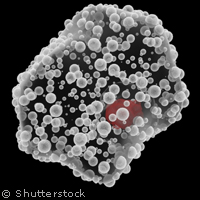Guess who's coming to dinner? White blood cells feed Leishmania parasites, study finds
Scientists in the UK have gained new insights into the way Leishmania parasites, which infect close to 12 million people worldwide, increase their rate of survival during the initial stages of infection. The results, published in the journal Public Library of Science (PLoS) Pathogens, could help in the development of new vaccines against the most common form of this disfiguring disease. Several species of Leishmania parasites cause different types of Leishmaniasis in humans. The most common form of the infection affects the skin causing painful ulcers and resulting in terrible scarring. The parasites are most common in tropical and sub-tropical countries, and are rare in richer nations. A severe form of Leishmaniasis leads to organ failure and kills approximately 60,000 people each year. Treatments vary in effectiveness and access to drugs is patchy at best; a vaccine is being sought urgently. Leishmania parasites are transmitted by sand flies. Infected flies carry a load of parasites in their midgut. To ensure that they are successfully deposited on another host, the parasites create a sticky gel that plugs their fly's gut; this plug must be regurgitated if the fly wants to eat. So when the fly is ready for a 'blood feed', it bites the unsuspecting human and regurgitates the parasite-loaded gel onto the freshly broken skin before digging in. Previous studies have indicated that that sand fly saliva somehow manipulates the human immune system into admitting the parasites; however, this latest research shows that the gel produced by Leishmania parasites plays a pivotal role in establishing infection in the new host. The major finding was that the gel recruits a large number of macrophages (white blood cells) to the site and then tricks them into 'feeding' the parasites rather than digesting them. 'Leishmaniasis is a very debilitating disease, yet we know comparatively little about the way the parasites are transmitted by sand flies,' said lead investigator Matthew Rogers of Imperial College London. 'This is because when scientists study the disease they usually inject the parasite into tissues without including the gel or the sand fly's saliva. Our new research shows that we must consider the way the parasites enter the body - along with the gel and saliva - if we are to recreate infection and get an accurate picture of what is going on.' Studying Leishmania-infected mice, the scientists observed that macrophages flocked in great numbers to the bite site in the first few days following infection. They also showed that this response was due to the presence of the parasite's promastigote secretory gel (PSG). PSG, they found, recruited approximately five times more macrophages than did sand-fly saliva. This finding sheds some light on how individuals who are immune to the saliva succumb to the disease in endemic areas. Normally, macrophages engulf a pathogen and produce nitric oxide to kill it. In the current study, Dr Rogers and his team showed that PSG manipulates these immune cells to engulf the parasites and then produce nutrients that are essential for growth instead. Provided with so many gracious hosts, the parasite has little problem establishing itself in its new home. 'Since arginase [an enzyme that makes the essential amino acid L-arginine, available] plays a crucial role in orchestrating wound repair in skin,' the authors speculate, 'it would appear that through the generation of PSG, Leishmania has evolved to exploit the wound response to the bite of the sand fly for its early survival.' In vitro studies also demonstrated that PSG influences parasite survival in the first 48 hours following infection. Indeed, the team observed that the proportion of both infected cells and the number of parasites within those cells increased eightfold in the presence of PSG. After two days, regardless of whether PSG was present, they found that the parasite population declined. The first two days, they discovered, are essential for establishing Leishmaniasis. 'Our new research shows that Leishmania parasites are very cunning: they make their own gel to control the human immune system so they can establish a skin infection,' Dr Rogers stated. 'There is more work to be done here; our previous work in mice has suggested that injecting a synthetic version of the gel into people might provide them with some protection against infection and we would like to explore this further.'
Countries
United Kingdom



